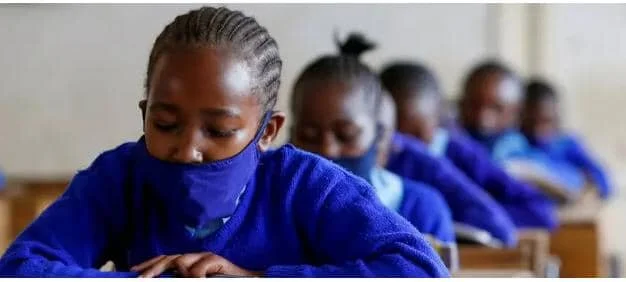Businesses Are Critical Partners In Advancing Girls’ Education. Here Is Why
The COVID-19 pandemic has exacerbated the barriers already faced by girls when it comes to access to school. If businesses have the know-how and resources that can help address some of these obstacles and turn ideas into action, aligning their actions with country-level priorities on girls’ education is essential to create avenues for collective impact at scale. Here is why.
Girls’ education is a vital force – not only does it change the lives of girls, but also has a tremendous ripple effect, with impacts ranging from improved health, stronger economies to the creation of a new generation of leaders.
Yet barriers to girls’ education persist. COVID-19 has exacerbated these barriers. With school closures, girls face disparity in accessing the internet, increased risks of gender-based violence and early marriage, which increases the likelihood of them never returning to school. Businesses have the know-how and resources that can help address some of these obstacles and turn ideas into action. Aligning business action with country-level priorities on girls’ education creates avenues for collective impact at scale.
For companies, there is a strong direct business case for investing in girls’ education. A report by the Global Business Coalition for Education states that educated girls will become skilled employees, innovators, consumers, and leaders – making girls’ education a core business opportunity for companies, in addition to serving social and strategic development initiatives.
In a recent dialogue on girls’ education, hosted by GPE and the UK’s Foreign, Commonwealth, and Development Office, Ministers of Education from GPE partner countries and business executives from major regional and global companies came together to discuss how the business community’s initiatives around girls’ education could be aligned to national education priorities. Here are three takeaways from the discussion on why businesses are critical partners in advancing girls’ education.
1. Different industries bring comparative strengths and expertise that can address key barriers
During the dialogue, Ministers of Education noted a growing mismatch between industry employment demand and supply, highlighting the need to integrate 21st-century skills in education systems to equip young women for the labor force. The business community is uniquely positioned to bridge this gap.
Companies can bring their voice to advocate for 21st-century skill development and advise ministries on what skills are most important to their industries. Through employee-engagement programs, they can mentor young women, support leadership training for girls and teachers, offer apprenticeship programs, and foster future women leaders in the workforce.
For example, Ecobank – a pan African financial institution and GPE business partner - collaborated with the Ekiti state government in Nigeria to empower women entrepreneurs in the region through special loans and training programs. These initiatives can give women the opportunity to break the barriers of poverty and financial exclusion, enabling them to send their daughters to school, access healthcare for their children, and empower future generations of girls.
During the ongoing COVID-19 pandemic, different industries came together to support continued learning for both girls and boys. Emerging partnerships between governments, telecom companies, technology companies, and content providers have provided free data and access to e-learning portals to ensure continuity of learning during school closures.
“COVID-19 has forced us to re-think how education is delivered. It has shown us that with strategic partnerships, it is possible to connect marginalized girls with learning opportunities - presenting a key opportunity to leapfrog to hybrid forms of education delivery.”
2. Businesses have access to local markets, offering great reach and community engagement opportunities
Businesses, through their employees and supply chains, have a strong community presence, making them valuable partners in helping raise awareness at national and community levels around girls’ education.
Ministers of education at the dialogue noted harmful behavioral and cultural norms such as child marriage and early pregnancies as one of the strongest barriers to girls’ education. Businesses, through their marketing infrastructure and local presence, can support effective messaging-campaigns that can help raise awareness among communities around these important issues.
For example, GPE’s partner Rotary worked with local business associations, to carry out door-to-door campaigns in Indian villages and convince parents to send their girls to school to complete their secondary schooling.
3. Businesses can be strategic partners in the design and implementation of gender-focused diagnostic tools
Businesses are equipped with evidence-based tools to measure the return on their investments. These tools can be adapted to various country contexts to help governments strengthen their education data systems and ensure better tracking of gender-disaggregated indicators.
Good data is a critical tool that helps policymakers identify gaps, focus resources and ultimately contribute to the global evidence base for gender responsive policy. GPE believes that the expertise and innovation of the business community can be harnessed to improve countries’ statistical capacity and data systems.
Given the multi-faceted nature of girls’ education, there is a need for coordinated cross-sectoral action to drive results to scale. The barriers and opportunities in girls’ education are almost never one dimensional – they require multiple stakeholders and cross-sectoral approaches.
However, establishing multi-stakeholder partnerships can be challenging. Among some of the challenges that companies noted around investing in girls’ education initiatives were finding strategic linkages to government plans, achieving scale, and finding the right partners on the ground.
To address these challenges, it is critical that we enhance alignment between corporate initiatives and national education priorities on girls’ education. GPE, with its convening power and multi-stakeholder partnership model, is uniquely positioned to facilitate this alignment.
The Youth Cafe’s objective on education is to Build a partnership between “innovative schools”, with a focus on “21st Century skills” and “student-centred learning methods”. Joint learning, innovation, and experience-sharing are achieved through partnerships, virtual and physical mobility exchanges. Students and teachers acquire the skills, knowledge and certifications needed to continuously improve teaching and learning outcomes and to succeed in the labour market. For more information, contact us.


